Scuba Diving Perth
Shore Diving
Rockingham Dive Trail
Rockingham Foreshore WA.
Site Info:
- Shore Dive. Wreck Dive.
- Max Depth: 18 meters.
- Dive Area: Approx. 100 meters wide (left to right) and approx. 50 meters depth (front to back) including 6 submerged wreck areas: 2 small boats, 2 small planes, the chicken coup, and a large tyre reef which is being created and extended, there is also a small tyre reef but this is mainly buried in the sand and only a few tyres are visible on the slope entering/exiting the dive site. The site originally had 4 boats but these have been covered by sand after the bank collapsed during a storm in 2008. There is a trail map located in the local car park but I question the accuracy of this.
- Visibility: Perfect day: 6 meters (very, very rare). Average day: 3 meters. Poor day: a real pea souper 1- 2 meters if you are lucky. Below is a selection of photographs showing how poor the vis can get.
- The dive trail is generally........ frustrating...... that's the only way to describe it. A lot effort appears to have gone in to designing it and maybe when it was originally conceived prior to the storm of 2008 it was a good site. However the site is just too much of a hit and miss every time you go down. And you find yourself asking the same questions over and over, "will the vis be ok, will there be much going on, will it be over-crowded". I generally feel that it hasn't lived up to its or maybe my expectations and there was a period that my wife and I refused to dive the site due to our joint frustration, that said I have returned and I am accepting it for what it is..... an opportunity to get wet, find a small gem or two (you will) and enjoy the privilege that is scuba diving.
- Ok enough bemoaning the site, lets get something good going. The dive trail is excellent if you are a novice diver and want to get some depth to your dive time. Like I said earlier there are 6 wreck areas, all of which are connected by a series of ropes (good idea). Ok you actually have two options to check out the wreck trail, option one descend at the flagged buoy, which most people do or the buoy without a flag...... so here goes........
DIRECTIONS
- This
site is about 30 minutes away from the City of Fremantle and, about 50
minutes from Perth CBD, depending on what route you take and the traffic
at the time.
- In short you need to get onto Flinders Lane which is off Patterson Rd or Rockingham Beach Rd. Page 445 UBD Street Directory of Perth.
- Follow Flinders Lane down to the foreshore from Patterson, you will cross Rockingham Beach Rd, if you are already on Rockingham Beach Rd then all you have to do is turn into the car park.
- This is the main car park that the majority of divers will use. That said if the car park is busy or you require some shade park on Rockingham Beach Rd on the right hand side as if facing the shoreline, there is shade provided by the trees and if you need a tank or gear then Bell Scuba is situated right there.
- Kit up, if you are a bit shy there are toilets on site. Make sure all your possessions are not on view and your car is secure, no car park is safe regardless of reputation.
- Regardless of where you parked and kitted up all you need to do is head to the beach. There are steps that will lead you down to the beach.
- Whilst on the beach do all your final checks: B (BCD): W (WEIGHTS): R (RELEASES): A (AIR): F (FINAL). We all have our own way of remembering this little check but I use this simple saying "Before Water Review A Friend". make your way into the water.
- Pretty much straight ahead of you will be a small buoy with a dive flag on it, make your way to the flag and descend to approximately 15 meters. The wreck site is linked by ropes so simply put, stick to the ropes and you shouldn't go wrong as the vis can get pretty poor at times.
Static Map
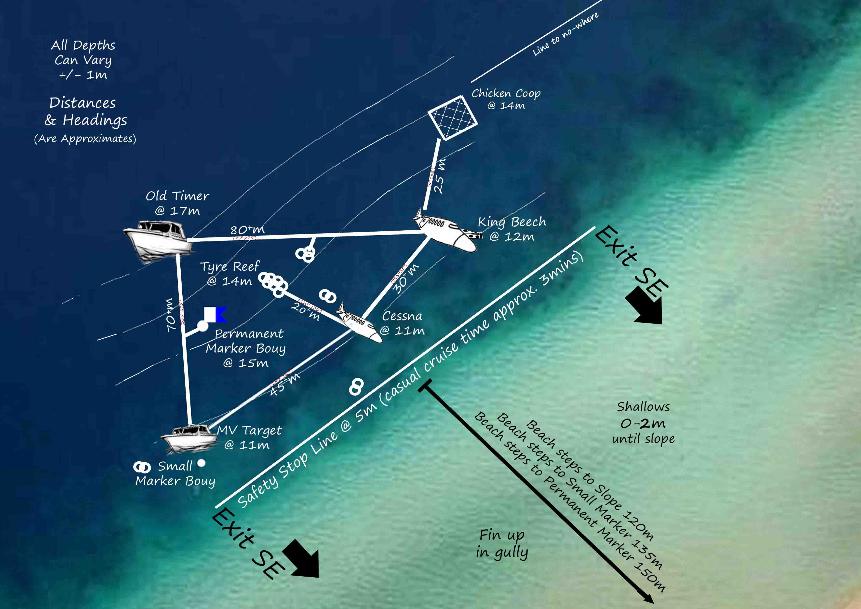
Dive Review
- The
dive trail is generally........ frustrating...... that's the only way
to describe it. A lot effort appears to have gone in to designing it and
maybe when it was originally conceived prior to the storm of 2008 it
was a good site. However the site is just too much of a hit and miss
every time you go down. And you find yourself asking the same questions
over and over, "will the vis be ok, will there be much going on, will it
be over-crowded". I generally feel that it hasn't lived up to its or
maybe my expectations and there was a period that my wife and I refused
to dive the site due to our joint frustration, that said I have returned
and I am accepting it for what it is..... an opportunity to get wet,
find a small gem or two (you will) and enjoy the privilege that is scuba
diving.
- Ok enough bemoaning the site, lets get something good going. The dive trail is excellent if you are a novice diver and want to get some depth to your dive time. Like I said earlier there are 6 wreck areas, all of which are connected by a series of ropes (good idea). Ok you actually have two options to check out the wreck trail, option one descend at the flagged buoy, which most people do or the buoy without a flag...... so here goes........
Option One
- NOTE: Please remember that lines and ropes get broken and get changed around from time to time between the wrecks, and little common sense is required whilst reading this review and when diving this site. I will update any changes that I become aware of, however give or take a few meters, the positioning of a line or two this description is pretty good.
- Prior to descending, there is a buoy with a dive flag approx. 50 meters swim after you have put your fins on. The first part of the water is shallow and walk-able approx. 50 - 70 meters depending on tide, so don't put your fins on too soon as the contour of the seabed raises and dips a wee bit and, if you rush to put your fins on, the next thing you know the water is only waist deep, not that really matters.
- Make your way to the dive flag and descend, use the anchor line if the vis is a bit poor or if you are new to diving and a little apprehensive. When you gently hit the seabed you will see how silty the dive trail is, best if you can put a little air in your BCD and prevent this from happening. You should be at about 15 meters depth at this point.
- Finding your way around could not be simpler and, the simple rule is, follow the ropes and you really shouldn't go wrong. There is a boat at approx. 18 meters heading roughly in a North, North Westerly direction, if you are going to dive this boat, as per diving guidelines, go to the deepest part of your dive first.
- When you have descended the anchor line and settled on the bottom take a moment to get your bearings. When everything has settled you will see a rope heading in a Northerly direction, attached to the anchor line just follow that until you come to the rear of the boat. Depending on visibility the boat will just spring out of the gloom....... explore and enjoy.
- Leaving the first boat and following your next line.
- Ok you can see the next line connected at the back of the boat. Follow this line and it will take you in a North, North Easterly direction heading slightly back to shore but not along the same rope as you arrived on. This rope will lead you into shallower water approx. 11 meters, at the end of this line is the first of the planes.
- When exploring you will see more ropes attached to the plane.
- At this point you have two options, in a North, North Westerly direction there is a rope that heads to the chicken coop, for approx. 30 meters max, this will drop you down to approx. 13 meters or.
- Follow the rope in a South Westerly direction until you swim to the next plane (on you left). I haven't dived this in a while and a new rope system is in place, the rope never used to be attached to the plane so be careful not to swim right past and in poor vis, swimming straight on by is not uncommon.
- After this plane there is a tyre reef, the rope to the reef is situated directly at the bottom of the plane. Return to the plane after you have investigated the reef and in a southerly direction follow the rope to the small boat. Your exit is South east up the steep slope to the line at 5 meters to do your safety stop.
Option Two
-
You can if you wish miss out the boat at 18 meters and descend a little earlier, there is a second buoy without a flag, approx. 20 - 30 meters before the buoy with the flag and to the south.
-
Descend here and you will be at approx. 12 meters, when you land on the bottom take a north westerly bearing and the swim about 5 meters this will take you to the last boat in the previous description (option one), explore and then continue to follow the rope at the rear to the middle wreck, the plane and tyre reef, explore and again continue along the rope to the first plane described in option one and if you wish carry on again from the bottom of this plane to the chicken coop.
-
In essence you have completed the trail in reverse but, you have missed out the boat at 18 meters because you should always start you dive at the deepest point. We usually do this route if we want to extend our time around the wrecks.
-
NOTE: there are some disused lines still attached that basically take you no-where, most probably old line from before the storm in 2008 I am guessing, if you take a wrong turn and up in The Town of Nowhere just reverse your direction and take an alternative roped path, you shouldn't go too wrong.
Video Map
Extra Info
- Apart from the vis the next frustrating part of this site is that it is used by loads of diving schools and, I know everybody has to learn, but just like we get frustrated with learner drivers on our roads, you will also get frustrated with learner divers. Especially when you have two or more schools down there, a couple of groups of divers, the vis is poor and everybody including yourself is kicking up silt.
- I was diving there one Sunday in November 2010, there where 3 schools, and a few groups of Sunday morning divers down there, in total there must of been 50 divers scrambling for bottom time, that's rare but it can happen.
- I really do appreciate what these guys are going through but, with that said it wont stop you getting frustrated, especially if you are a novice diver, I promise you. Because I know as a novice diver I want the best dive vis and space I can get.
- So in a nutshell pick your dive day and time when it will be less crowded, mid week, earlier the better, if you go at weekends then earlier is definitely the better, head to be in the water before 0830 hrs, that way you should be in and out before the schools get in there.
- One other good point about Rockingham DT is that the dive site is generally sheltered from a lot of the windy weather so when other sites are shut out you can usually get a dive in at Rockingham.
- Last but not least, if you can, I find that Rockingham is best dived at night, the vis is not really a problem as everything is lit by your torch light and is really up close and personal. Speak to one of the local dive shops to see if they have a night dive running and tag along if you can.
HERE WE GO
-
Ok lets get to some pictures..... remember me talking about the vis..... how could you forget, I went on about it so much I sounded like I had tourettes and OCD, well below are the pictures about the vis. I want to take a moment and explain this, I dive for me, I take photographs for me and I am not ashamed to say I edit some of these photographs on a PC for my own personal pleasure, in no way, shape or form do I claim to be a photographer, when I am clicking away I am tourist on vacation taking holiday snaps, so yes the photographs contrast/colour is regularly enhanced to help bring the pictures to life but, I feel that with this dive site you need to see at least a few pictures of the real deal when it comes to the visibility, after that I am not worrying too much.
ORIGINAL
(UN-FLASHED PHOTOGRAPH)
ENHANCED
(EDITED CONTRAST/COLOUR)
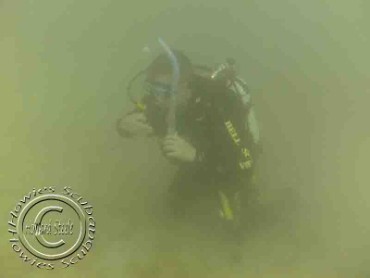
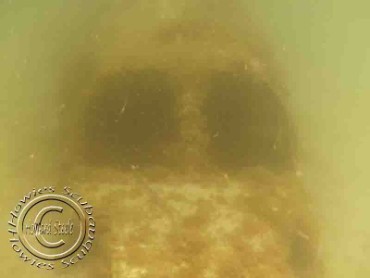
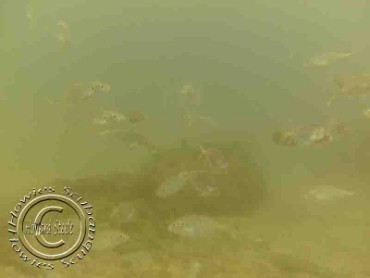
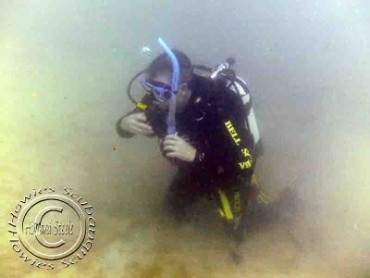
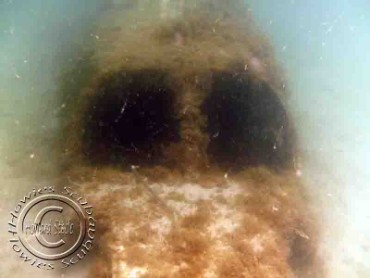
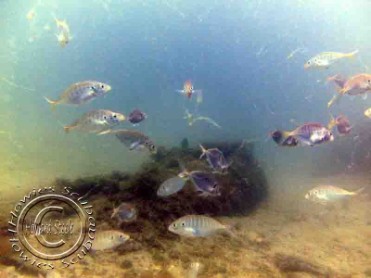
LIFE AT ROCKINGHAM DIVE TRAIL
SEAHORSES
-
These little beauties are one of my Buddys' favourites and we are always on the look out for these when we dive at Rockingham.
-
When you are following the rope, take a brief moment every now and then to look for these little guys, if you are lucky and have a keen eye you may see one or two hanging off the rope.
-
This Seahorse (left) was bobbing along the top of the boat at 18 meters. I caught a nice little bit of video of it. However it was trying its best to hide from me so I didn't pursue too hard.
-
If you look closely (below) you can see the swollen belly of this male, the male carries its young, and releases them when it believes they have the best chance of survival. The female inserts the eggs into the males brooding pouch and he will fertilize the eggs, then he gives birth to miniature fully formed Seahorses. A mans' work is never done.......
PLANES, TRAINS & AUTO-MOBILES
OR SHOULD I SAY
COOPS, ROPES, PLANES & BOATS
-
99% (not an official stat) of what you will see at Rockingham DT lives within or around the wrecks. That said other than getting turned around a couple of times, I have never explored much further. Here is a collection of photographs of life around and in the wrecks.
-
Top left two photographs are from the chicken coup, this is a wired framed shelter that you can swim through or around, it has a small tyre wall (top left) also, with the occasional life chilling or hiding within it.
-
Top right two photographs are of the old ropes that connect each wreck, they can get covered with sand at times but generally they are about 0.5 meters above the seabed. Don't forget to look for Seahorses, Fan-worms and other macro life. You will occasional get the odd fish or two swimming around these also.
-
Above (left two) are, as you can easily see taken at one of the planes, take a good look inside all the wrecks, the planes only give you enough space to realistically poke your head or camera in, unless of course in a previous life you were a performing contortionist, or you are a really really tiny person (like me).
-
At the boat wrecks (right two) you can actually venture further in, the wrecks are tiny so don't expect too much, you can literally swim in turn around and swim out, having a reverse gear would actually help its that small.
-
Take a torch as all the wrecks have dark little corners and sometimes there is an abundance of life hiding in the gloom that you will actually miss without some type of lighting source.
- Above is just a few pictures of life in and around the wrecks. The first picture is quite interesting, the fish which I am unsure if its a boxfish or filefish most likely a Mosaic Leatherjacket, was so slender like a pancake squeezed into that slot that I almost missed it, the fish had to be less than an inch (26mm) in thickness and blended extremely well in the poor orangey vis.
OTHER MOMENTS AT ROCKINGHAM DT
MOON JELLYFISH
-
Andy A just about to be devoured by a Moon JellyFish.
STRIPED CATFISH
-
Below is a group of schooling Juvenile Striped Catfish. They will take it in turns to forage at the bottom of the school, safety in numbers comes to mind seeing these. You may find a small school in a ball at the back of one of the planes (videos), that said if you haven't got a torch it may be difficult to notice them. Picture taken April 2010
YELLOWTAIL TREVALLY
-
A school of whirlwinding Yellowtail Trevally (below). Not on this day but in November 2010, I was just ascending the DT and doing my safety stop at 5 meters with my buddy on that day Stevie G, when a massive school of huge Yellowtails decided to entertain us. They circled us for about five minutes, I am sure if we would have stayed longer they would have entertained us for ages, I was able to get some video but the quality was very poor unfortunately.
WESTERN KING WRASSE
-
A Western King Wrasse taking a fancy to my Buddy's fins, maybe it thought they looked cute, considering the colours.
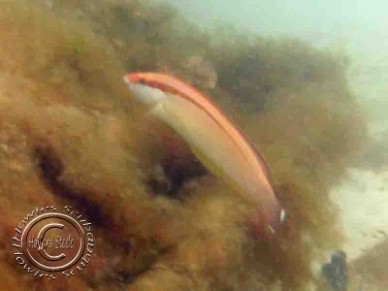
YELLOW SPOTTED BOARFISH
-
This is apparently a rare fish to be seen at Rockingham, so I have been told. Boarfish seldom come in so close to the shore. On this day (November 2010) in the corner of my eye I saw this large fish swimming off so, I gave chase, but it had got away from me, hence the poor quality of picture (left).
- As I turned around another one was right in front of me (right), it looks like a really nicely composed picture but, it was so close I had the camera pressed to my chest and just clicked, I guess sometimes you get lucky. I think these are Yellow Spotted Boarfish, I am unsure if this includes the group that has venomous spines..... so maybe getting this close, without getting injured, I got lucky twice.
A COUPLE OF FAVOURITES
-
A couple of my favourites before the final gallery. I love these two pictures. You could not of positioned these Rough Bullseyes and the Crested Morwong any better, even if they were made out of stone. The pose is perfect, every time I see it, I imagine the Crested Morwong as some Crime Lord and the Roughies (appropriately named) are its henchmen, I love it, and I think I love it more because it was the first dive I had used my camera so everything was still shiny and new and secondly because it happened by chance.
-
And the second picture has a special place in my heart, I bet you didn't realise people could jump when submerged, well maybe they can but 1.5 meters off the seabed, now that's impressive, well that's what happened when my Buddy disturbed this Blue Manna Swimmer Crab, it was hilarious (its hard to laugh under water), and the first time we had encountered this type of crab. The Blue Swimmer Crab is common at Rockingham, just check out the seabed on you ascent and there is a good chance you will disturb one, watch it move, it looks like a flamenco dancer with steroidal castanettes (videos).
PLEASE REFRESH THIS PAGE IF FACEBOOK LIKE BUTTON DOES NOT WORK
IF YOU'RE NOT GOING DOWN: THEN WHERE THE HELL ARE YOU GOING